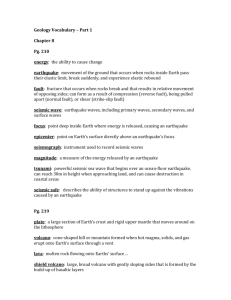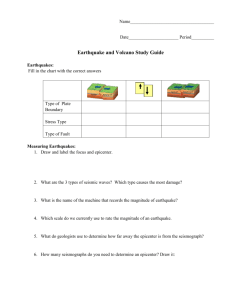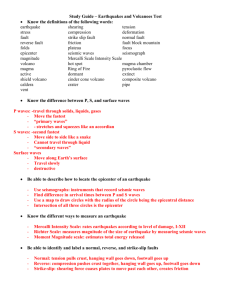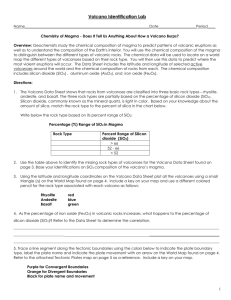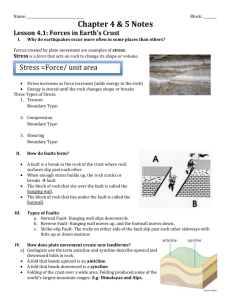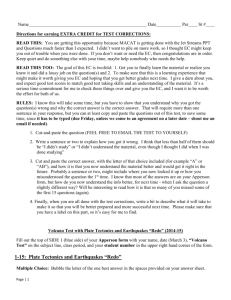Earthquakes and Volcanoes Study Guide 2013 Know the facts about
advertisement
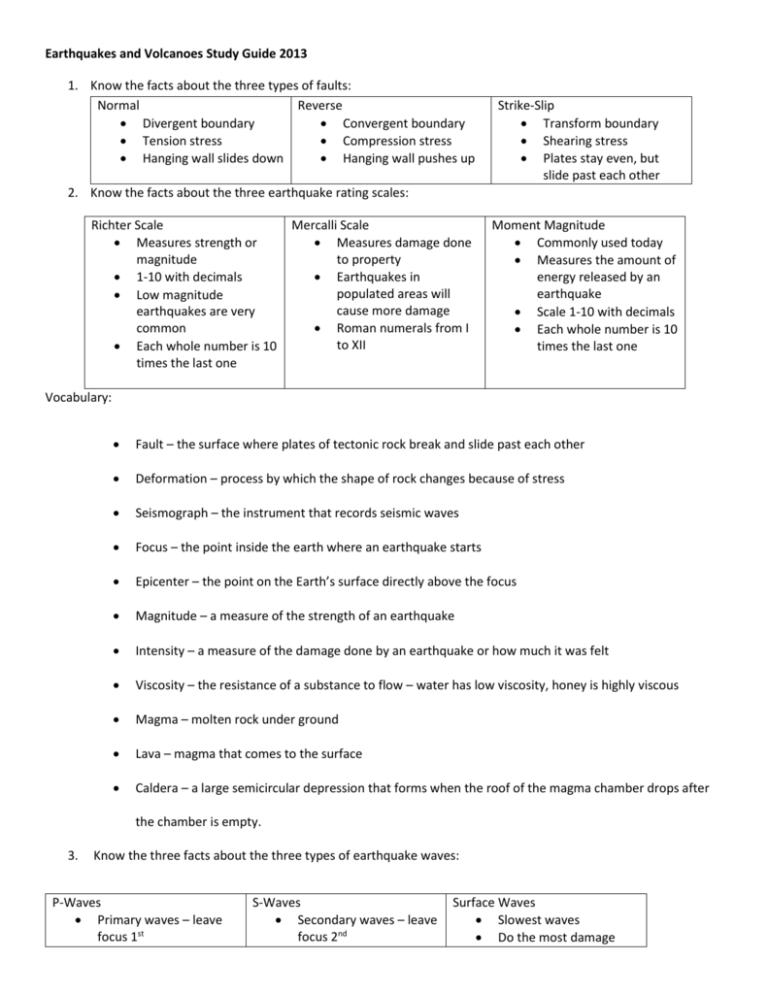
Earthquakes and Volcanoes Study Guide 2013 1. Know the facts about the three types of faults: Normal Reverse Divergent boundary Convergent boundary Tension stress Compression stress Hanging wall slides down Hanging wall pushes up Strike-Slip Transform boundary Shearing stress Plates stay even, but slide past each other 2. Know the facts about the three earthquake rating scales: Richter Scale Measures strength or magnitude 1-10 with decimals Low magnitude earthquakes are very common Each whole number is 10 times the last one Mercalli Scale Measures damage done to property Earthquakes in populated areas will cause more damage Roman numerals from I to XII Moment Magnitude Commonly used today Measures the amount of energy released by an earthquake Scale 1-10 with decimals Each whole number is 10 times the last one Vocabulary: Fault – the surface where plates of tectonic rock break and slide past each other Deformation – process by which the shape of rock changes because of stress Seismograph – the instrument that records seismic waves Focus – the point inside the earth where an earthquake starts Epicenter – the point on the Earth’s surface directly above the focus Magnitude – a measure of the strength of an earthquake Intensity – a measure of the damage done by an earthquake or how much it was felt Viscosity – the resistance of a substance to flow – water has low viscosity, honey is highly viscous Magma – molten rock under ground Lava – magma that comes to the surface Caldera – a large semicircular depression that forms when the roof of the magma chamber drops after the chamber is empty. 3. Know the three facts about the three types of earthquake waves: P-Waves Primary waves – leave focus 1st S-Waves Secondary waves – leave focus 2nd Surface Waves Slowest waves Do the most damage Move very fast Move slower Can travel through solids Travel through ONLY AND liquids solids Move through pressure Move side to side and release – like slinky 5. Know the differences in the two types of eruptions: Explosive Very destructive Explode with lots of force and speed High viscosity Pyroclastic material Move like water waves, up and down in a circle or side to side Non-Explosive Most common type Low viscosity lava 6. Describe: Active volcano Erupting now or soon Dormant volcano “sleeping” volcano could erupt in the future Extinct volcano Has not erupted in recorded history and probably won’t ever again. 7. Know the characteristics of the three main types of volcanoes: Shield volcano Formed from repeated nonexplosive eruptions Dome with gently sloping sides Very large Composite volcano Formed from alternating explosive and nonexplosive eruptions Broad base, steeper at the top Medium size 8. Know the sizes of tephra: I told you in class to skip this question Cinder cone volcano Formed from explosive eruptions. Smaller with steep slopes Larger material lands closer to the volcano 9. Know the parts/definitions of a volcano: THIS SECTION WILL BE REVIEWED IN CLASS Crater Ash cloud Lateral vent Lava Vent Rock Magma chamber Shade in the area that would represent the caldera. – all areas above the magma chamber would sink if the magma chamber top collapsed 10. Know where most volcanoes form. – Along plate boundaries where there is a subduction zone. – Along the Ring of fire 11. What is the Ring of Fire? – The plate boundary surrounding the Pacific Ocean has so many earthquakes and volcanoes that it is called the Ring of Fire. 12. What type of rock does a volcano create after it erupts? Extrusive igneous rock 13. Review Plate Tectonics study guide. 14. Know how volcanoes can affect climate. Some very explosive volcanoes can sent pyroclastic dust and ash into the upper atmosphere. It stays there for a long time and blocks the suns rays. That causes the global temperature to decrease.







